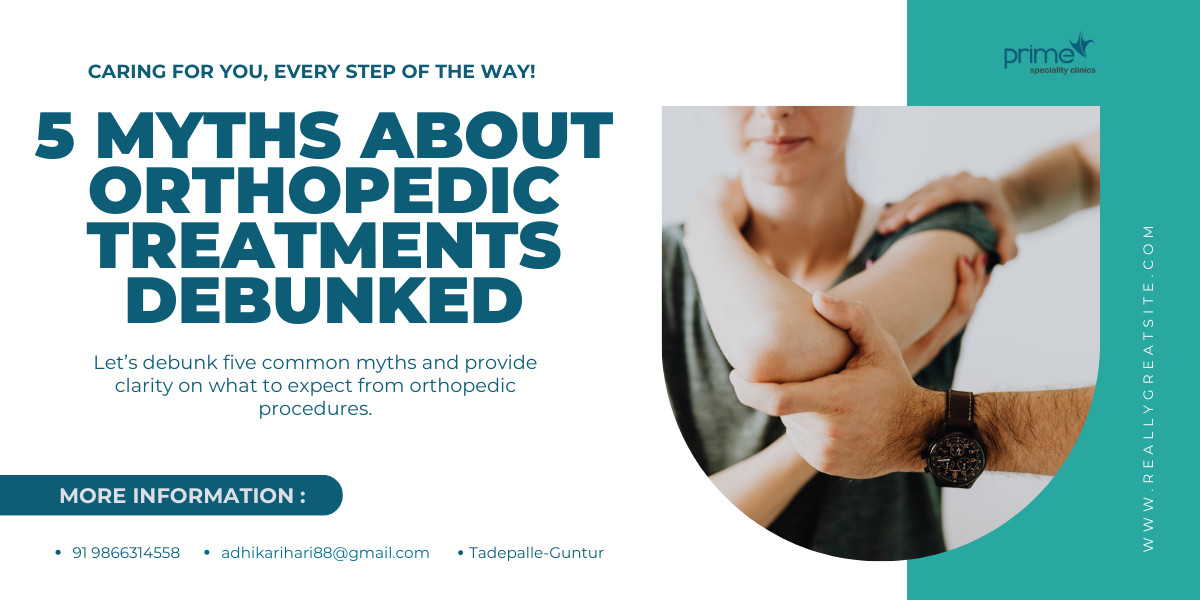
5 Myths About Orthopedic Treatments Debunked
Orthopedic treatments encompass a wide range of procedures that help patients manage musculoskeletal issues. From minor injuries to chronic conditions, orthopedic care plays a pivotal role in enhancing mobility and improving quality of life. Unfortunately, several myths surrounding these treatments can create unnecessary fear or confusion. Let’s debunk five common myths and provide clarity on what to expect from orthopedic procedures.
Myth 1: Surgery is the Only Solution for Orthopedic Issues
One of the biggest misconceptions about orthopedic treatments is that surgery is the only way to resolve musculoskeletal problems. While surgery can be a necessary step in some cases, it is far from the first option. In fact, the best orthopedic hospitals in Vijayawada and beyond often prioritize non-invasive treatments such as physical therapy, medication, and lifestyle changes before recommending surgery. Understanding orthopedic treatment means recognizing that many conditions can be managed without going under the knife.
Myth 2: All Orthopedic Surgeries are the Same
Many people believe that all orthopedic surgeries are complex and involve a long recovery process. In reality, there are several types of orthopedic surgeries, ranging from minimally invasive procedures to more involved operations. Common orthopedic procedures like arthroscopy (used for joint issues) or joint replacement surgery have vastly different recovery times and risks. For example, arthroscopic surgeries are typically less invasive and require a shorter recovery period compared to full joint replacements. Having an orthopedic surgery guide can help patients understand which procedure suits their condition best.
Myth 3: Orthopedic Surgeries Have Long Recovery Times
Another widespread myth is that recovery from orthopedic surgery takes an extremely long time. While some procedures, such as major joint replacements, do require an extended recovery period, many surgeries today are much less invasive than they used to be. Technological advancements in orthopedic procedures have led to shorter hospital stays and faster recovery times. With proper rehabilitation and following the orthopedic surgery recovery guidelines, many patients can return to their normal routines quicker than anticipated.
Myth 4: Only Athletes Need Orthopedic Care
A common stereotype is that orthopedic care is only for athletes or individuals with extremely active lifestyles. However, orthopedic conditions can affect anyone, from young children with developmental disorders to older adults dealing with arthritis. Orthopedic issues arise from a variety of causes including injury, aging, or chronic diseases. The best orthopedic hospitals in Vijayawada treat patients of all ages and backgrounds, offering specialized care that meets individual needs, whether you're an athlete or not.
Myth 5: Orthopedic Treatments are Painful
Many people fear orthopedic treatments because they assume they will be extremely painful. While some discomfort is natural during the healing process, advancements in medical technology have significantly reduced the pain associated with both treatments and recovery. Surgeons now use minimally invasive techniques and enhanced pain management strategies to ensure patients are as comfortable as possible. In fact, with appropriate post-surgical care and rehabilitation, many patients find relief from the chronic pain that led them to seek treatment in the first place.
Conclusion
Orthopedic treatments have come a long way in terms of both techniques and patient care. Misconceptions about these procedures can cause unnecessary anxiety, but understanding orthopedic treatment options can help alleviate those fears. Whether you're considering a common orthopedic procedure or a more complex surgery, having accurate information is key. The best orthopedic hospitals in Vijayawada offer a wide range of treatments and expert guidance, ensuring that patients receive the care they need without misconceptions clouding their judgment.
By debunking these myths, patients can approach their orthopedic treatment with confidence, understanding that recovery and relief are well within reach.